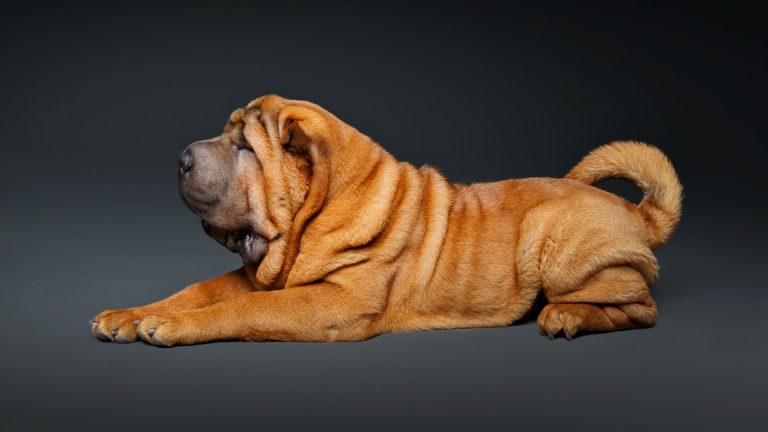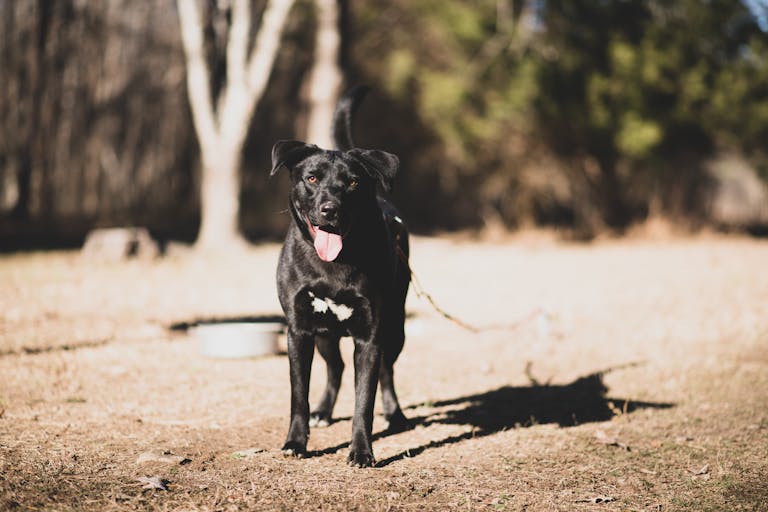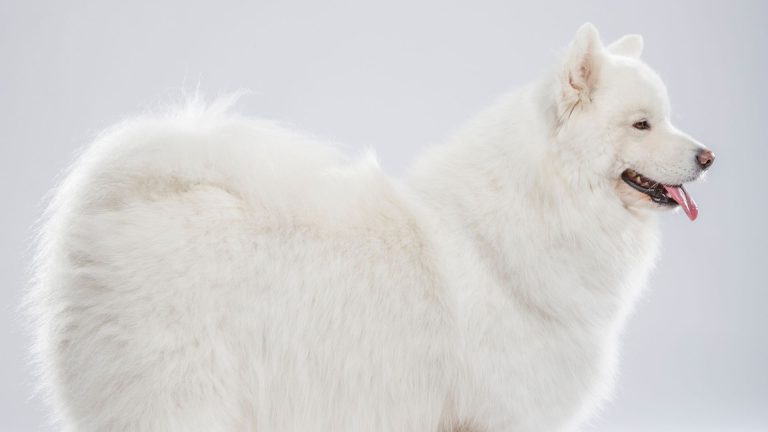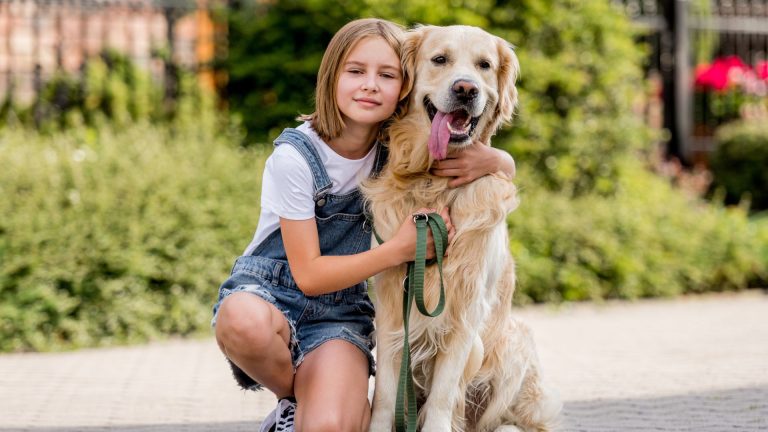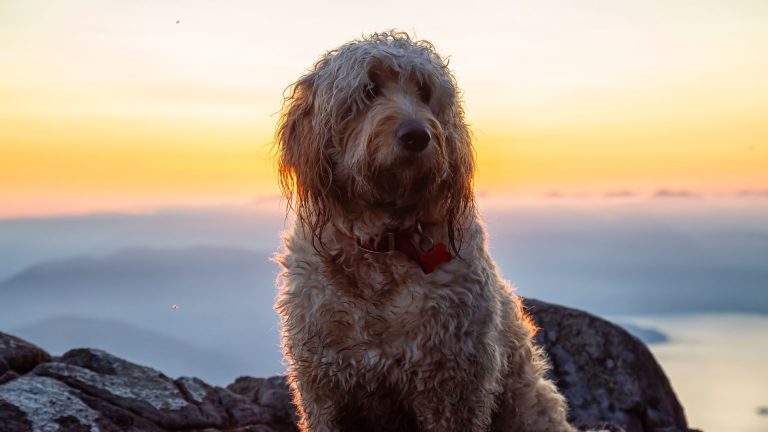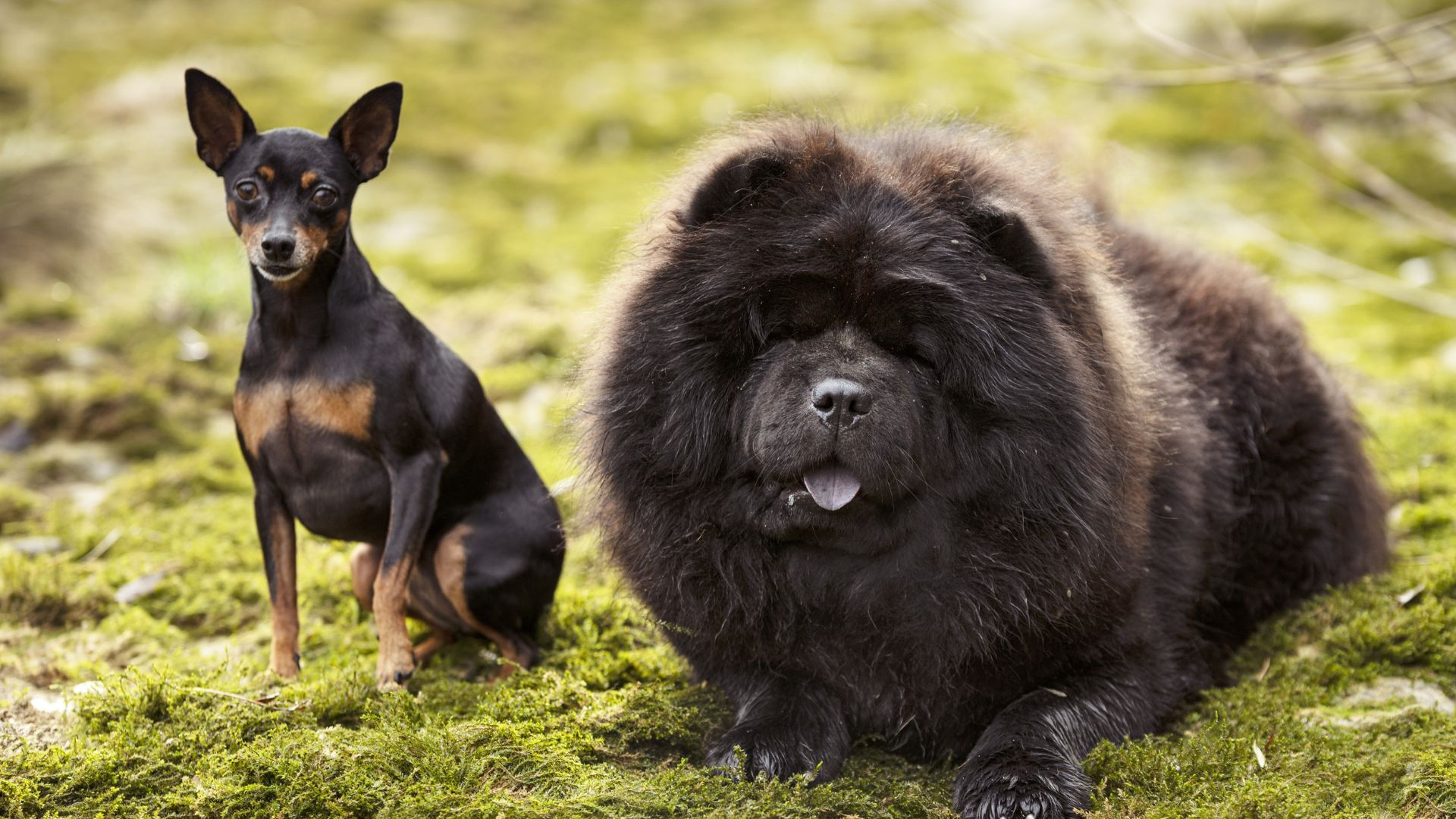
Contents
Dog breeds have captivated people worldwide for centuries. From the loyal Labrador Retriever in America to the regal German Shepherd in Europe, the diversity of dog breeds reflects the unique histories and cultures of different regions. Chinese dog breeds, in particular, are renowned for their rich cultural heritage and ancient history. Each breed, with its distinctive features and characteristics, has been cherished and revered for centuries in China.
The purpose of this article is to delve into the world of Chinese dog breeds, exploring their rich histories, unique traits, and why they make exceptional pets. From the wrinkled Shar Pei to the regal Pekingese, each breed has its own story to tell. Whether you are a dog enthusiast or considering adopting a new furry friend, this article showcases the beauty and uniqueness of Chinese dog breeds.
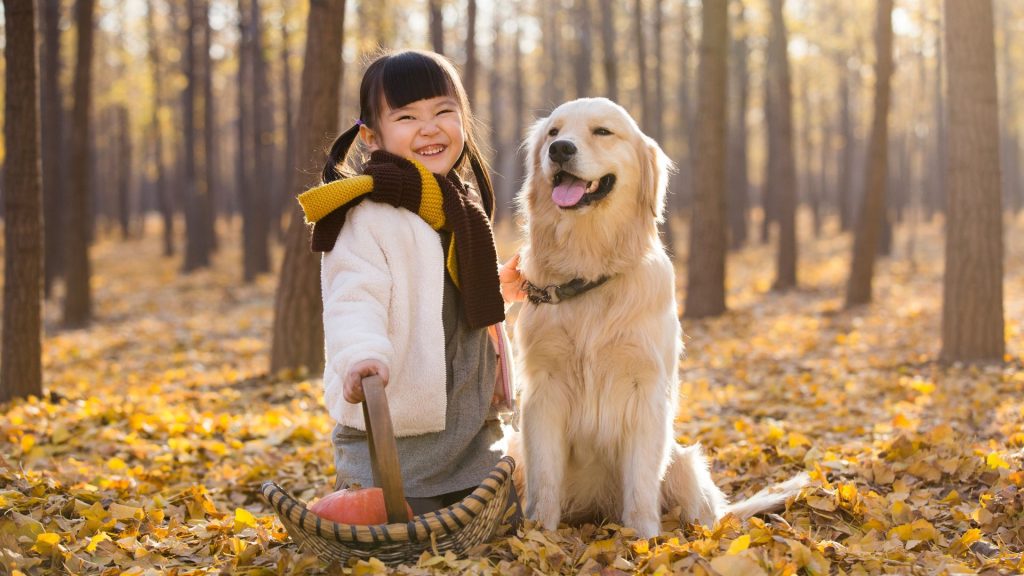
The Historical Significance of Chinese Dog Breeds
Chinese dog breeds have ancient origins, deeply intertwined with the history and culture of China. Archaeological evidence suggests that domesticated dogs have been part of Chinese society for thousands of years. In ancient China, dogs were not only pets but also held symbolic and practical significance. They were often depicted in Chinese art and literature, symbolizing loyalty, protection, and good fortune. Certain breeds were considered sacred and were kept by royalty and nobility as symbols of status and prestige.
Traditional Uses of Dogs in China
Throughout history, Chinese dog breeds have served various roles:
- Hunting: Breeds like the Chinese Chongqing Dog were used for hunting due to their agility, strength, and keen senses. These dogs assisted in tracking and capturing game.
- Guarding: The Tibetan Mastiff, with its imposing size and protective nature, was traditionally used to guard livestock and property. Its fierce loyalty and territorial instincts made it an excellent watchdog.
- Companionship: Small breeds like the Shih Tzu and Pekingese were bred primarily for companionship. These dogs were often kept by royalty, serving as lapdogs and providing emotional support.
Influence of Chinese Dog Breeds on Global Canine Culture
Chinese dog breeds have significantly impacted global canine culture, influencing breeding practices and contributing to the diversity of dog breeds worldwide. Many of these breeds have gained international recognition due to their unique characteristics and charming personalities.
For example, the Shar Pei, with its distinctive wrinkled skin and blue-black tongue, has become beloved in many countries, admired for its unique appearance and loyal nature. Similarly, the Shih Tzu and Pekingese, known for their regal demeanor and affectionate temperament, have found homes around the world.
Moreover, the breeding techniques and knowledge developed in China have contributed to the advancement of canine genetics and veterinary science globally. The meticulous care and selective breeding practices employed by Chinese breeders have set standards for health and conformation in dog breeds.
The historical significance of Chinese dog breeds is vast, encompassing their ancient roots, traditional roles, and lasting influence on global canine culture. These breeds reflect the rich cultural heritage of China and continue to bring joy and companionship to people worldwide.
Shar Pei
The Shar Pei is one of the oldest dog breeds, with origins tracing back over 2,000 years to the Han Dynasty in China. Initially bred in the Guangdong province, Shar Peis were used for various purposes, including hunting, herding, and guarding. Their name, which translates to “sand skin” in Cantonese, refers to their rough, short coat. The breed almost faced extinction during the 20th century due to political turmoil and the cultural revolution in China, but dedicated breeders helped revive its population, making the Shar Pei a beloved breed worldwide.
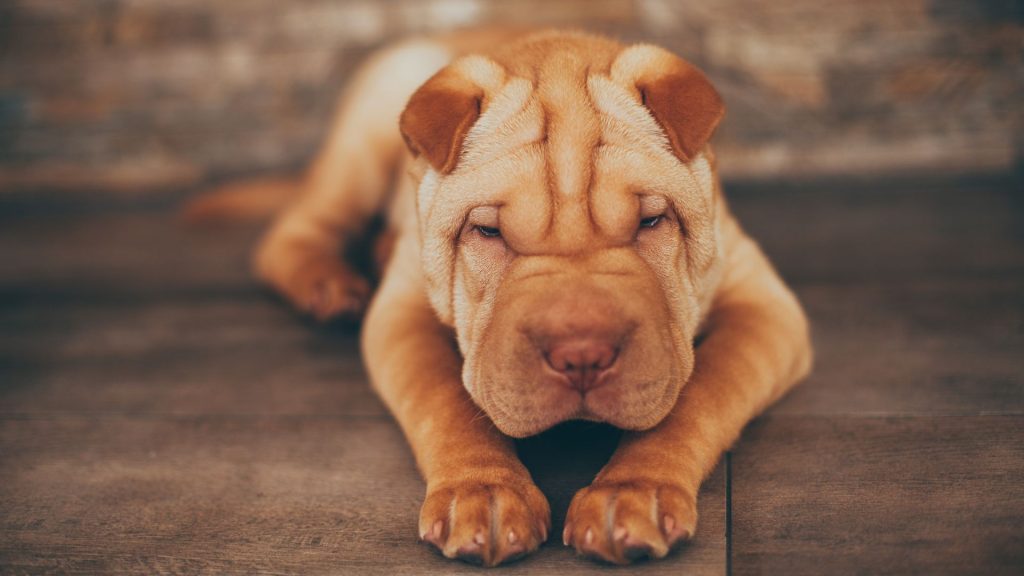
Physical Characteristics
The Shar Pei is easily recognizable by its unique physical traits:
- Wrinkles: The breed’s most distinctive feature is its deep wrinkles, especially noticeable on the face and neck. These wrinkles give the Shar Pei its characteristic look and charm.
- Blue-Black Tongue: Like the Chow Chow, the Shar Pei has a blue-black tongue, adding to its unique appearance.
- Coat: The coat is short, bristly, and rough to the touch, often described as feeling like sandpaper.
- Build: Shar Peis are medium-sized dogs with a sturdy and muscular build, giving them an appearance of strength and stability.
Personality Traits and Temperament
Shar Peis are known for their loyal, calm, and independent nature. They form strong bonds with their families and are often wary of strangers, making them excellent watchdogs. Despite their somewhat aloof demeanor, they are affectionate and devoted to their loved ones. Shar Peis are also known for their intelligence and can be quite stubborn, requiring consistent and firm training.
Care and Grooming Needs
Caring for a Shar Pei involves specific grooming and maintenance routines to ensure their health and well-being:
- Wrinkle Care: The breed’s deep wrinkles can trap dirt and moisture, leading to skin infections. Regular cleaning and drying of the wrinkles are essential to prevent skin issues.
- Coat Maintenance: The short coat requires minimal grooming, but regular brushing helps remove dead hair and keeps the skin healthy.
- Bathing: Shar Peis should be bathed as needed, with special attention to drying their wrinkles thoroughly.
- Exercise: These dogs require moderate exercise to stay healthy. Daily walks and playtime in a secure area are ideal.

Health Considerations
Shar Peis are prone to certain health issues, largely due to their unique physical characteristics:
- Skin Problems: The deep wrinkles can lead to skin infections and irritations if not properly cared for.
- Hip Dysplasia: This common issue in many breeds can also affect Shar Peis, leading to joint pain and mobility issues.
- Eye Conditions: Entropion, where the eyelids roll inward, is a common problem in Shar Peis, often requiring surgical correction.
- Respiratory Issues: The breed’s short muzzle can sometimes cause breathing difficulties, especially in hot or humid weather.
Why the Shar Pei Makes a Good Pet
Despite their unique care needs, Shar Peis make excellent pets for the right families. Their loyalty and protective nature make them great companions and watchdogs. They are well-suited to families who can provide consistent training and socialization, as well as those willing to dedicate time to their specific grooming needs. Shar Peis are relatively low-energy dogs, making them suitable for both apartment living and homes with yards. Their calm and independent nature means they can be left alone for reasonable periods, making them a good choice for working families.
The Shar Pei is a distinctive and ancient breed that offers loyalty, protection, and companionship. With proper care and attention, they make wonderful and devoted pets.
Shih Tzu
The Shih Tzu, often referred to as the “Lion Dog,” has a rich history intertwined with Chinese royalty. Believed to have originated over a thousand years ago, the Shih Tzu was a favored companion of Chinese emperors, particularly during the Ming and Qing Dynasties. These little dogs were bred and kept within the imperial palace, cherished for their regal appearance and affectionate nature. The Shih Tzu was often given as gifts to nobility and was considered a symbol of status and wealth. Their name, which means “lion” in Mandarin, reflects their majestic appearance and esteemed position in Chinese culture.

Appearance and Unique Features
The Shih Tzu is easily recognized by its distinctive and elegant appearance:
- Coat: They have a long, flowing double coat that can come in a variety of colors and patterns. The coat is soft and luxurious, often styled in topknots to keep the hair out of their eyes.
- Face: Shih Tzus have a short, flat muzzle with a prominent, round head and large, dark eyes that give them an endearing, expressive look.
- Size: They are small dogs, typically weighing between 9 to 16 pounds and standing about 9 to 10.5 inches tall at the shoulder.
Personality and Behavior
Shih Tzus are known for their friendly, affectionate, and outgoing personalities. They thrive on human companionship and enjoy being the center of attention. These dogs are generally good-natured, making them excellent companions for families, singles, and seniors alike. They are playful and enjoy interactive games, but they are also content to cuddle on the couch. Shih Tzus are known for their adaptability and can do well in various living environments, from apartments to larger homes.
Grooming and Maintenance
Maintaining a Shih Tzu’s coat requires regular grooming to keep it healthy and tangle-free:
- Daily Brushing: Their long coat needs to be brushed daily to prevent mats and tangles. Using a quality dog brush and detangling spray can make this task easier.
- Bathing: Regular baths, usually every three to four weeks, help keep their coat clean and healthy. Special attention should be given to thoroughly drying their coat to prevent skin issues.
- Trimming: Many Shih Tzu owners opt for professional grooming to keep their dog’s coat in a manageable length. Regular trimming of the hair around the eyes, ears, and paws is essential.
- Dental Care: Shih Tzus are prone to dental problems, so regular brushing of their teeth is important.
- Eye and Ear Care: Regular cleaning of their eyes and ears can help prevent infections and tear staining.

Common Health Issues
Shih Tzus are generally healthy dogs, but they are prone to certain health issues:
- Brachycephalic Syndrome: Due to their short muzzles, Shih Tzus can experience breathing difficulties, especially in hot or humid weather.
- Dental Problems: Their small mouths can lead to overcrowded teeth and dental issues. Regular dental care is crucial.
- Hip Dysplasia: This condition, while more common in larger breeds, can also affect Shih Tzus.
- Eye Problems: Shih Tzus are susceptible to various eye issues, including cataracts and dry eye.
- Allergies: They can be prone to skin allergies, often requiring special shampoos or medications.
Suitability as a Family Pet
Shih Tzus make wonderful family pets due to their friendly and affectionate nature. They get along well with children and other pets when properly socialized. Their small size and relatively low exercise needs make them ideal for apartment living. However, they do require significant grooming and attention to their health needs. Families who can commit to their grooming routine and provide them with plenty of love and companionship will find Shih Tzus to be delightful and loyal pets. Their adaptability and loving temperament make them suitable for a wide range of households, from active families to quieter, single-person homes.
The Shih Tzu is a charming and regal breed with a rich history and a loving nature. With proper care and attention, they make delightful and devoted companions, bringing joy and affection to their families.
Pekingese
The Pekingese, also known as the “Lion Dog,” has a storied history deeply rooted in Chinese royalty. These small, regal dogs were bred over 2,000 years ago and were cherished companions of the Chinese imperial family. According to legend, the breed was created by the Buddha, who shrunk a lion down to dog size. The Pekingese were considered sacred and were often found in the laps of emperors and empresses, symbolizing nobility and divinity. They were so valued that commoners had to bow to them, and stealing a Pekingese was punishable by death. This breed’s royal heritage adds to its mystique and charm.
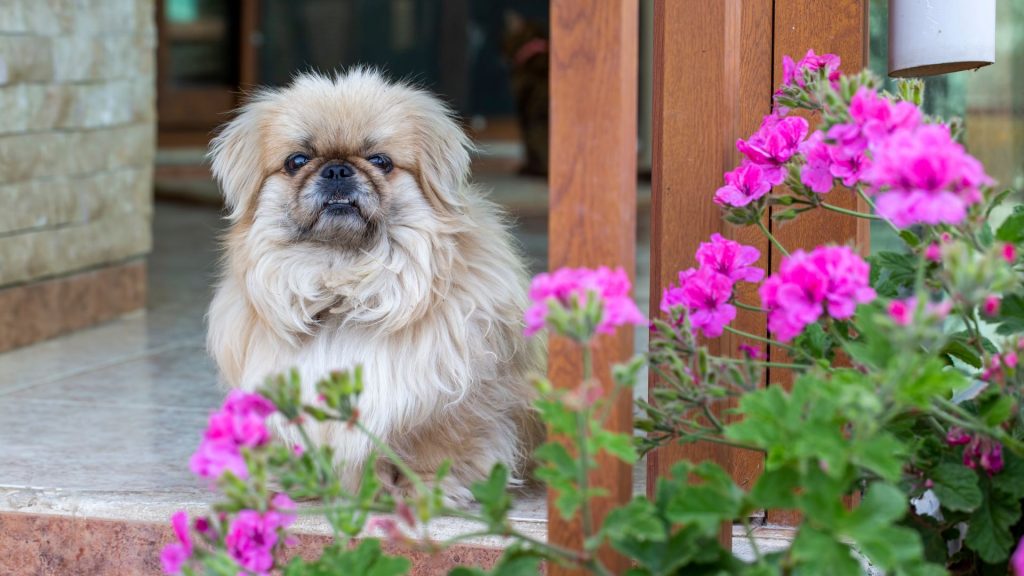
Physical Appearance
The Pekingese is renowned for its distinctive and majestic appearance:
- Lion-Like Mane: One of the most striking features of the Pekingese is its abundant, long, and flowing coat, which resembles a lion’s mane. This luxurious coat comes in various colors and patterns.
- Compact Size: Pekingese are small dogs, typically weighing between 7 to 14 pounds and standing about 6 to 9 inches tall at the shoulder. Despite their small size, they have a sturdy and well-muscled body.
- Distinctive Face: They have a flat, brachycephalic face with a broad skull, large, dark eyes, and a short, wrinkled nose. Their facial expression often appears dignified and aloof.
Temperament and Personality
Pekingese are known for their confident, independent, and somewhat aloof nature. Despite their small stature, they possess a fearless and courageous demeanor, often described as “lion-hearted.” These dogs are deeply loyal to their families and can be quite protective. They tend to be reserved with strangers but affectionate with those they trust. Pekingese are intelligent and can be stubborn, requiring patient and consistent training. They enjoy being the center of attention and are well-suited to a quiet, calm environment where they can feel secure and loved.
Grooming Requirements
The Pekingese’s long, flowing coat requires regular grooming to keep it healthy and beautiful:
- Daily Brushing: Their coat needs daily brushing to prevent mats and tangles. A slicker brush and a metal comb are useful tools for this task.
- Bathing: Regular baths, typically every three to four weeks, help maintain their coat’s cleanliness and luster. Careful drying is essential to prevent skin issues.
- Trimming: Regular trimming of the hair around the eyes, ears, and paws is necessary to maintain their neat appearance.
- Dental Care: Due to their small mouths, Pekingese can be prone to dental issues. Regular tooth brushing and dental check-ups are important.
- Eye and Ear Care: Regular cleaning of their eyes and ears helps prevent infections and tear staining.
Health Concerns
Pekingese are generally healthy, but they are prone to certain health issues:
- Brachycephalic Syndrome: Their flat faces can cause breathing difficulties, particularly in hot or humid weather.
- Eye Problems: Their prominent eyes are susceptible to injuries, infections, and conditions such as dry eye.
- Dental Issues: Their small mouths can lead to dental overcrowding and periodontal disease.
- Intervertebral Disc Disease: This condition, affecting the spine, can cause pain and mobility issues.
- Skin Conditions: Their dense coat and skin folds can make them prone to skin irritations and infections if not properly groomed.
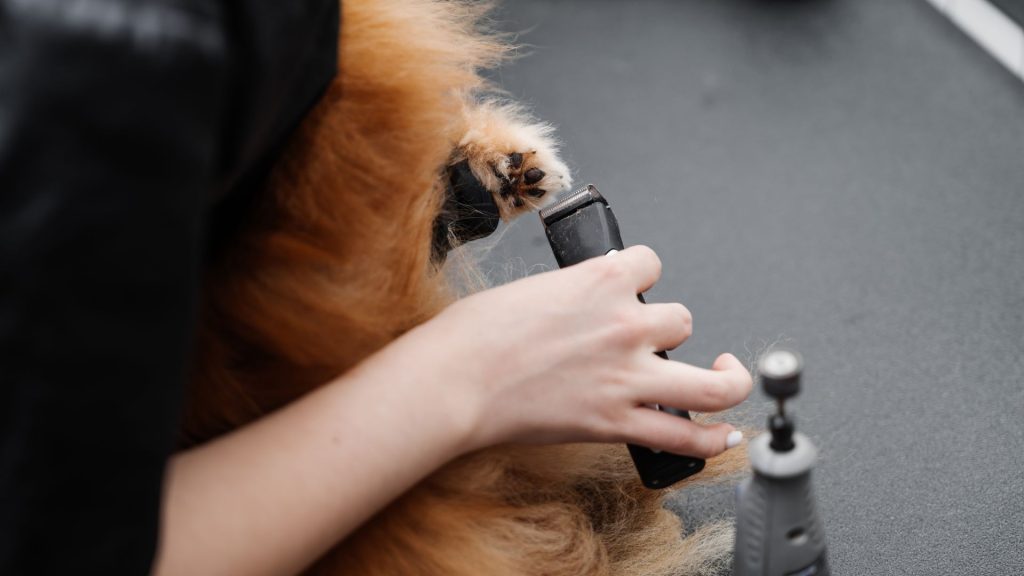
Ideal Living Conditions and Family Suitability
Pekingese are best suited to quiet, calm households where they can be the center of attention. They do well in apartments due to their small size and relatively low exercise needs. A few short walks and indoor play sessions are sufficient to keep them happy and healthy. Pekingese are generally good with older children and other pets when properly socialized, but they may not tolerate rough handling from very young children. They thrive in environments where they receive plenty of love, attention, and gentle care.
The Pekingese is a dignified and loyal breed with a rich royal heritage. Their distinctive appearance and independent personality make them unique and charming companions. With the right care and environment, they can bring a sense of nobility and joy to their families.
Chow Chow
The Chow Chow is one of the oldest and most recognizable dog breeds, with a history that dates back over 2,000 years. Originating in northern China, this breed was depicted in ancient artifacts and writings, indicating its long-standing presence and significance. Historically, Chow Chows served various roles, including hunting, herding, pulling carts, and guarding property. They were valued for their strength, endurance, and protective nature. In ancient China, they were often kept by nobles and were sometimes referred to as the “Dog of the Tang Empire,” highlighting their esteemed status.
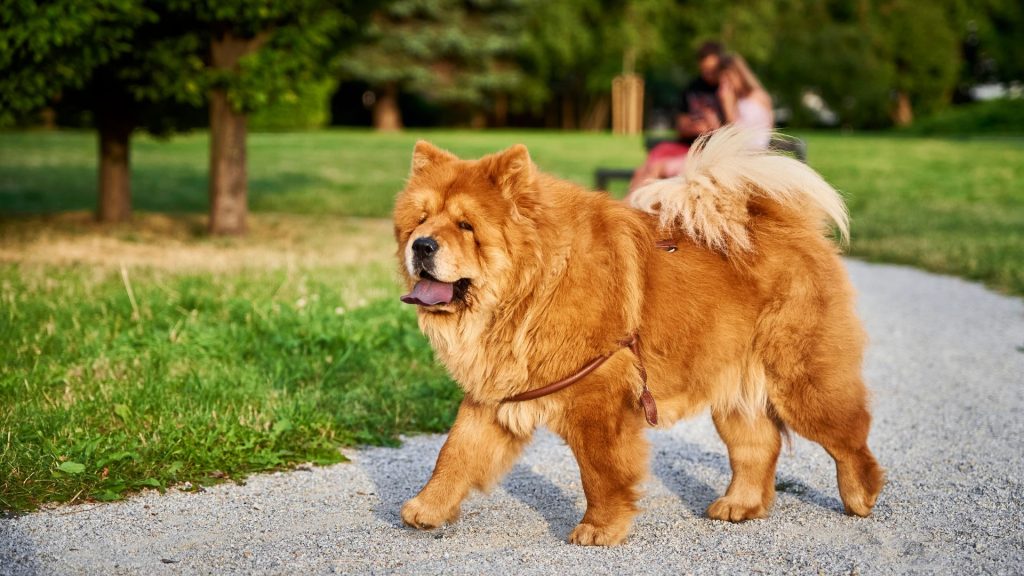
Distinctive Features
Chow Chows are easily recognizable due to their unique and striking appearance:
- Lion-Like Appearance: They have a dense double coat that gives them a lion-like mane, particularly around the neck and shoulders. This thick fur can come in various colors, including red, black, blue, cinnamon, and cream.
- Blue-Black Tongue: One of the most distinctive features of the Chow Chow is its blue-black tongue, a trait shared with only a few other breeds. This characteristic adds to their exotic and unique appeal.
- Build: Chow Chows are medium-sized dogs with a sturdy and muscular build. They have a broad skull, deep-set almond-shaped eyes, and small, triangular ears that stand erect.
Behavioral Traits and Temperament
Chow Chows are known for their dignified, reserved, and independent nature. They are often described as cat-like in their behavior, displaying a certain aloofness and self-reliance. Despite their reserved demeanor, they are fiercely loyal and protective of their families.
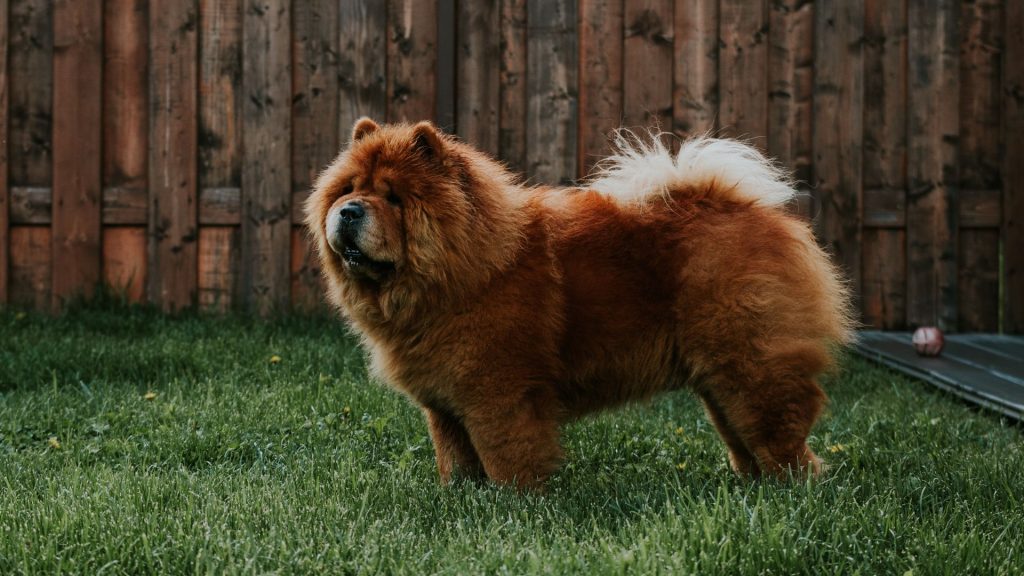
Chow Chows are generally calm and well-mannered, making them suitable for apartment living if they receive adequate exercise. However, their independent nature can sometimes be mistaken for aloofness or stubbornness. Early socialization and consistent training are crucial to ensure they grow into well-behaved adults.
Chow Chows can be wary of strangers, making them excellent watchdogs. They are also known to be quite territorial, which, coupled with their loyalty, means they will protect their home and family if they perceive any threat. Despite their somewhat distant demeanor, they can be very affectionate and bond strongly with their family members.
Grooming and Care
Chow Chows require regular grooming to maintain their thick, luxurious coats:
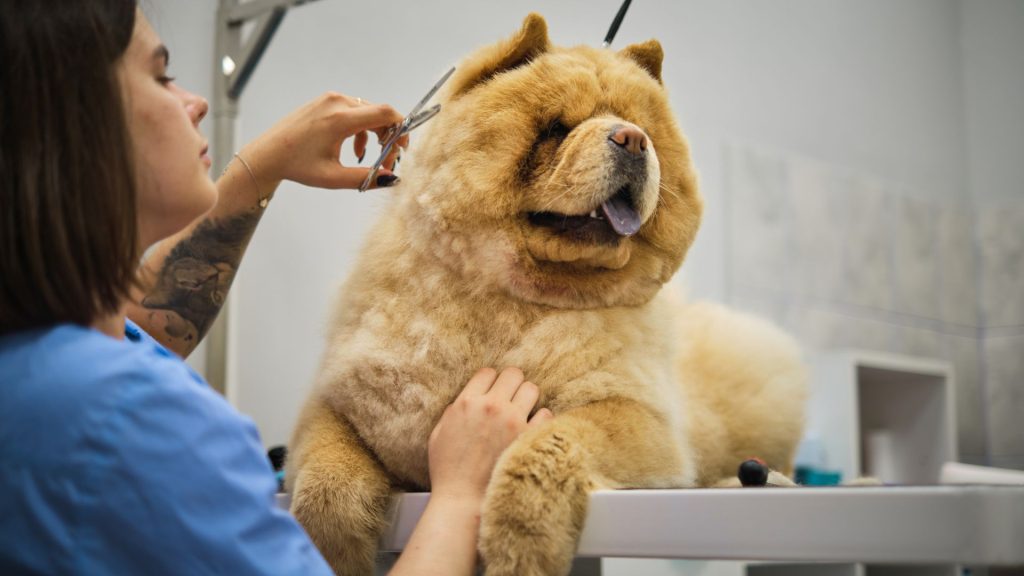
- Brushing: Their dense double coat needs to be brushed at least twice a week to prevent matting and tangling. During shedding seasons, daily brushing is recommended.
- Bathing: Regular bathing, usually once a month, helps keep their coat clean and free of dirt and debris. Ensure thorough drying to avoid skin issues.
- Trimming: Regular trimming around the paws and ears can help maintain their neat appearance and prevent infections.
- Dental Care: Regular brushing of their teeth is essential to prevent dental issues.
- Eye and Ear Care: Regular checks and cleaning of their eyes and ears help prevent infections and ensure overall health.
Health Issues to Watch Out For
Chow Chows, like all breeds, are prone to certain health issues that owners should be aware of:
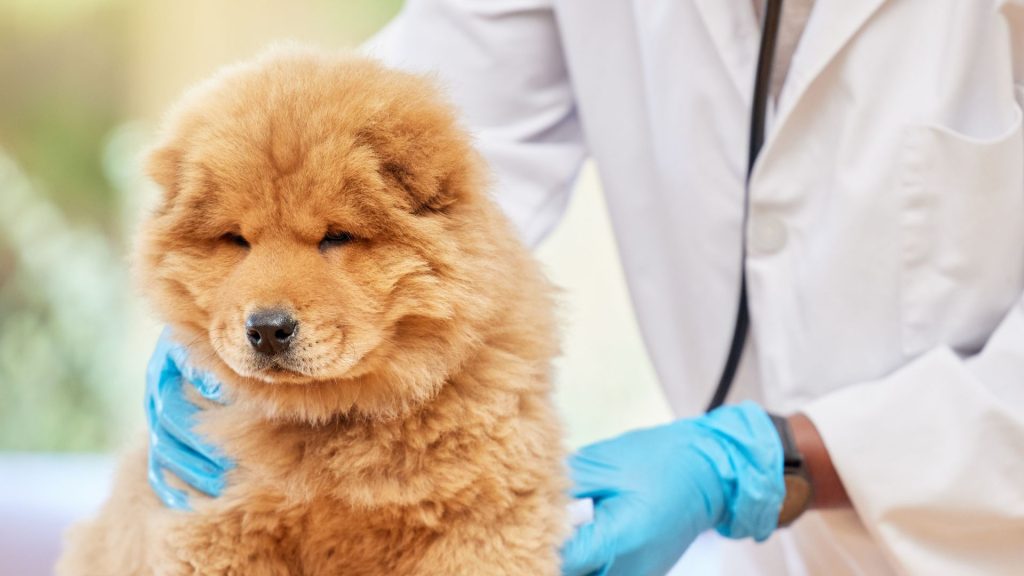
- Hip Dysplasia: This genetic condition can lead to joint pain and mobility issues. Regular check-ups and maintaining a healthy weight can help manage this condition.
- Entropion: This condition, where the eyelids roll inward, can cause irritation and damage to the eye. Surgical correction is often required.
- Elbow Dysplasia: Another joint-related issue that can cause discomfort and lameness.
- Hypothyroidism: This endocrine disorder can lead to weight gain, lethargy, and skin issues. It is usually managed with medication.
- Allergies: Chow Chows can be prone to skin allergies, requiring special diets or treatments.
Compatibility with Families and Other Pets
Chow Chows can be excellent family pets, but they require a specific environment to thrive:
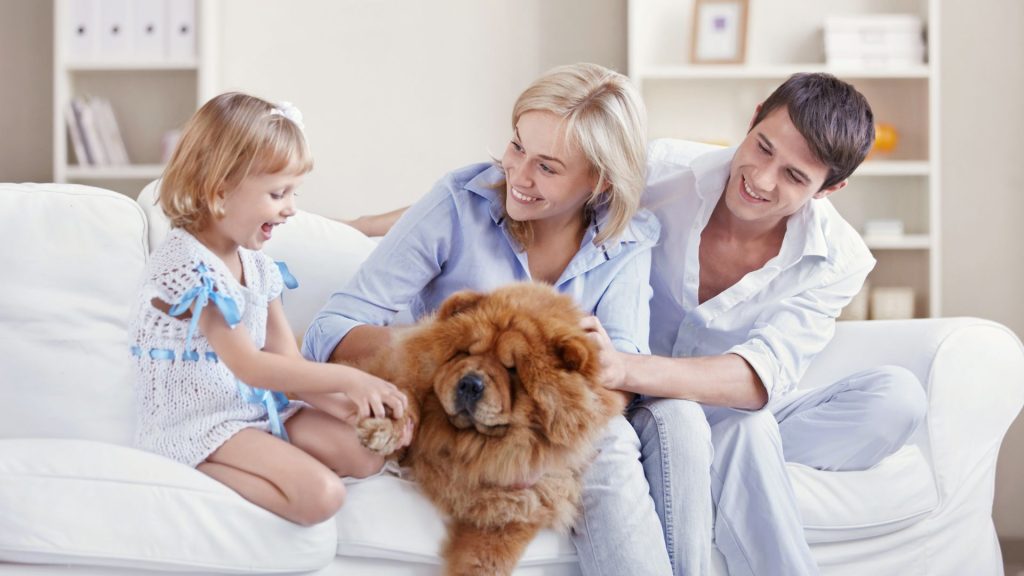
- Families: They are best suited to families who understand and respect their independent nature. Chow Chows are typically patient and gentle with children but should always be supervised during interactions, especially with younger kids.
- Other Pets: With proper socialization, Chow Chows can coexist with other pets. However, their territorial nature means they may not always get along with other dogs, particularly those of the same sex. Early socialization and introductions are key to ensuring harmony in a multi-pet household.
The Chow Chow is a dignified and unique breed with a rich history and distinctive appearance. Their loyal and protective nature makes them excellent companions for families who can provide consistent training and proper care. With the right environment and attention, Chow Chows can bring a sense of majesty and loyalty to any home.
Tibetan Mastiff
The Tibetan Mastiff, known for its imposing presence and protective instincts, has a rich history deeply embedded in Tibetan culture. Originating in the Himalayas, this ancient breed was traditionally used by nomadic tribes of Tibet, Nepal, and India to protect sheep from predators such as wolves, leopards, and bears. Tibetan Mastiffs were also highly valued by Tibetan monks and monasteries, where they served as guardians. Their ability to endure harsh weather conditions and rugged terrains made them indispensable in their roles as protectors of livestock and property.
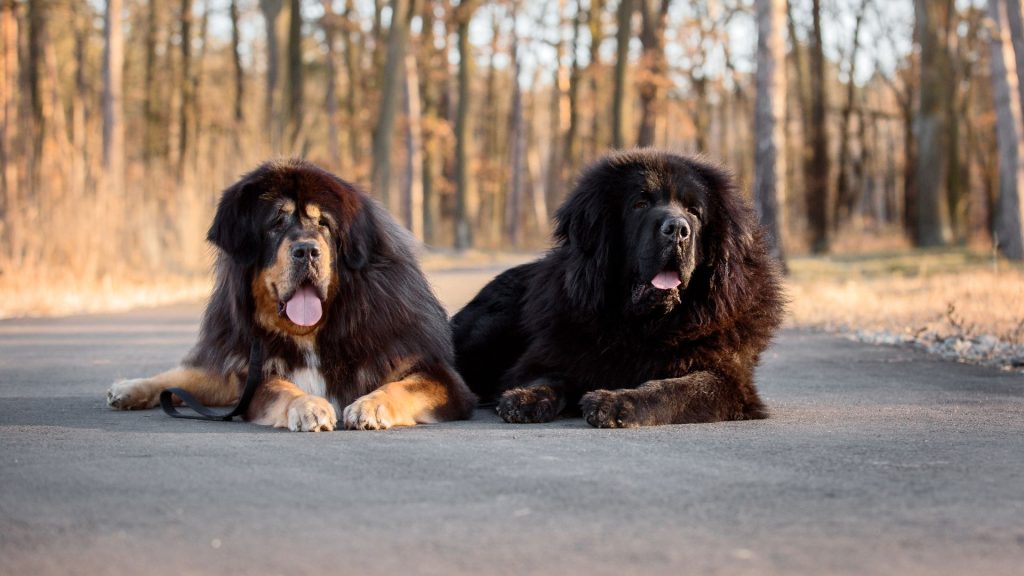
Physical Characteristics
The Tibetan Mastiff is a large and powerful breed, with several distinctive features:
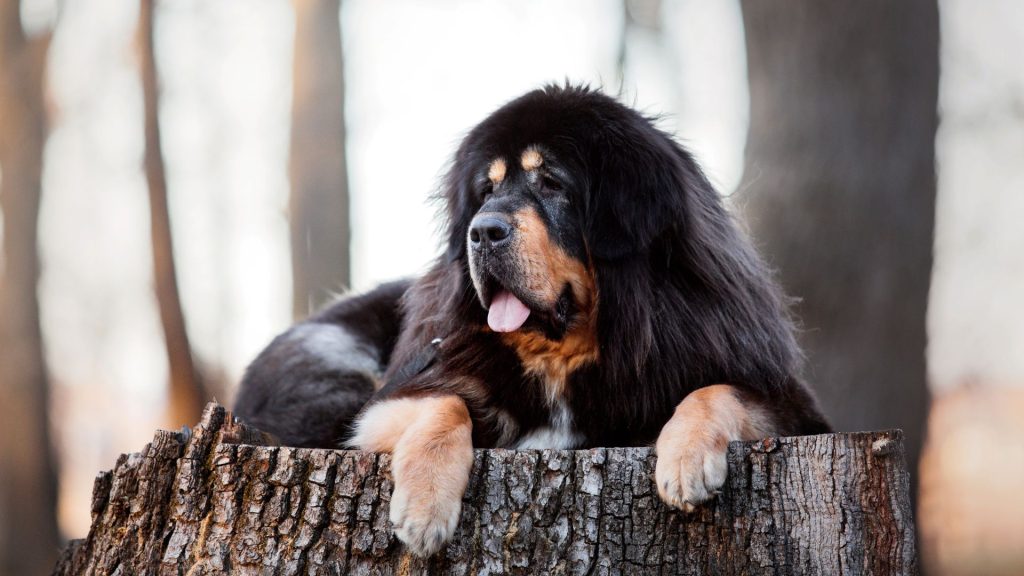
- Large Size: Tibetan Mastiffs are among the largest dog breeds, with males typically weighing between 90 to 150 pounds and females weighing between 70 to 120 pounds. They stand between 24 to 30 inches tall at the shoulder.
- Thick Coat: They have a dense double coat that is long and thick, providing excellent insulation against the cold. The coat comes in various colors, including black, brown, blue, and gold, often with white markings.
- Imposing Appearance: Their massive build, broad head, and deep-set, expressive eyes give them an imposing and majestic appearance. The thick mane around their neck and shoulders enhances their lion-like look.
Temperament and Behavior
Tibetan Mastiffs are known for their independent, protective, and loyal nature. They have a strong guarding instinct and are naturally wary of strangers, making them excellent watchdogs. These dogs are intelligent and can be quite stubborn, which can make training a challenge. However, they are also known for their calm and composed demeanor, especially when properly socialized and trained.
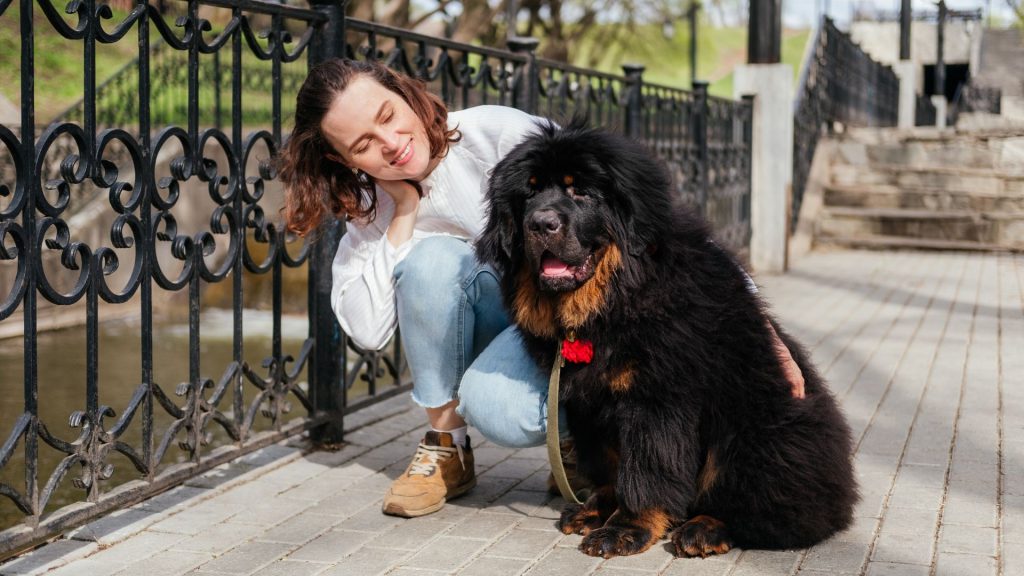
Tibetan Mastiffs are very loyal to their families and can be affectionate and gentle with those they trust. They are generally good with children but should always be supervised due to their large size and protective nature. Their independent streak means they can be aloof and may not always seek constant attention, preferring to observe their surroundings quietly.
Care and Grooming Needs
Caring for a Tibetan Mastiff requires attention to their grooming and exercise needs:

- Brushing: Their thick double coat requires regular brushing, at least two to three times a week, to prevent matting and reduce shedding. During shedding seasons, daily brushing is recommended.
- Bathing: Bathing should be done as needed, usually every few months. Ensure their coat is thoroughly dried to prevent skin issues.
- Exercise: Tibetan Mastiffs need regular exercise to stay healthy and happy. Daily walks and playtime in a secure, fenced area are ideal. They enjoy activities that allow them to explore and use their natural guarding instincts.
- Dental Care: Regular brushing of their teeth is important to prevent dental problems.
- Ear and Eye Care: Regular checks and cleaning of their ears and eyes help prevent infections and maintain overall health.
Health and Lifespan Considerations
Tibetan Mastiffs are generally healthy, but they are prone to certain health issues:
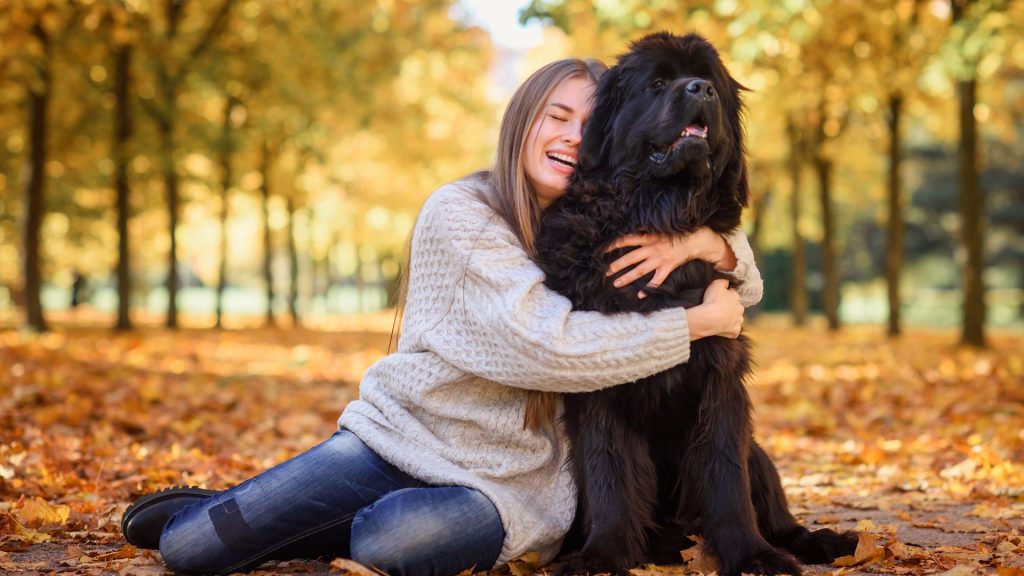
- Hip Dysplasia: This genetic condition can lead to joint pain and mobility issues. Regular check-ups and maintaining a healthy weight can help manage this condition.
- Hypothyroidism: This endocrine disorder can cause weight gain, lethargy, and skin issues. It is usually managed with medication.
- Elbow Dysplasia: Another joint-related issue that can cause discomfort and lameness.
- Eye Conditions: They can be prone to certain eye conditions such as entropion and progressive retinal atrophy.
- Life Span: Tibetan Mastiffs have a lifespan of around 10 to 14 years, which is relatively long for a large breed. Regular veterinary care and a healthy diet can help ensure they live a long and healthy life.
Suitability as a Guardian and Family Pet
Tibetan Mastiffs make excellent guardians and family pets for the right households:
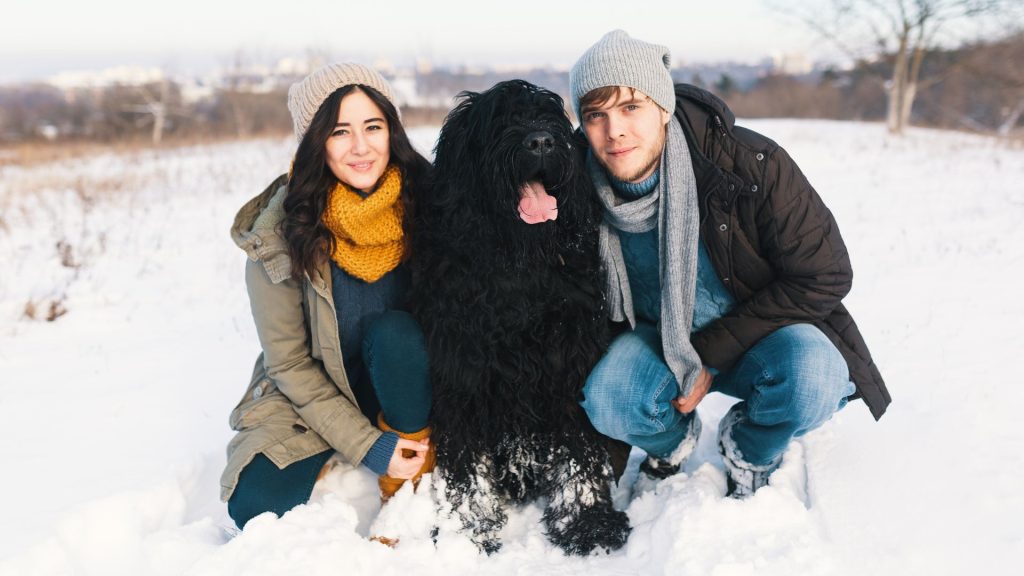
- Guardians: Their natural guarding instincts, loyalty, and protective nature make them ideal for homes that require a watchdog. They are particularly well-suited to properties with large, secure outdoor spaces where they can patrol and feel in control.
- Family Pets: They can be great family pets for experienced dog owners who understand their unique needs. Tibetan Mastiffs require consistent training, socialization, and a firm yet gentle hand. They are generally good with children and other pets when properly introduced and socialized.
Tibetan Mastiff is a majestic and powerful breed with a rich history and a strong protective instinct. Their loyal and calm nature makes them excellent guardians and companions for families who can provide the proper care, training, and environment. With the right attention and love, Tibetan Mastiffs can be wonderful and devoted family members.
Chinese Crested
The Chinese Crested is a distinctive breed known for its unique and striking appearance, which comes in two varieties:
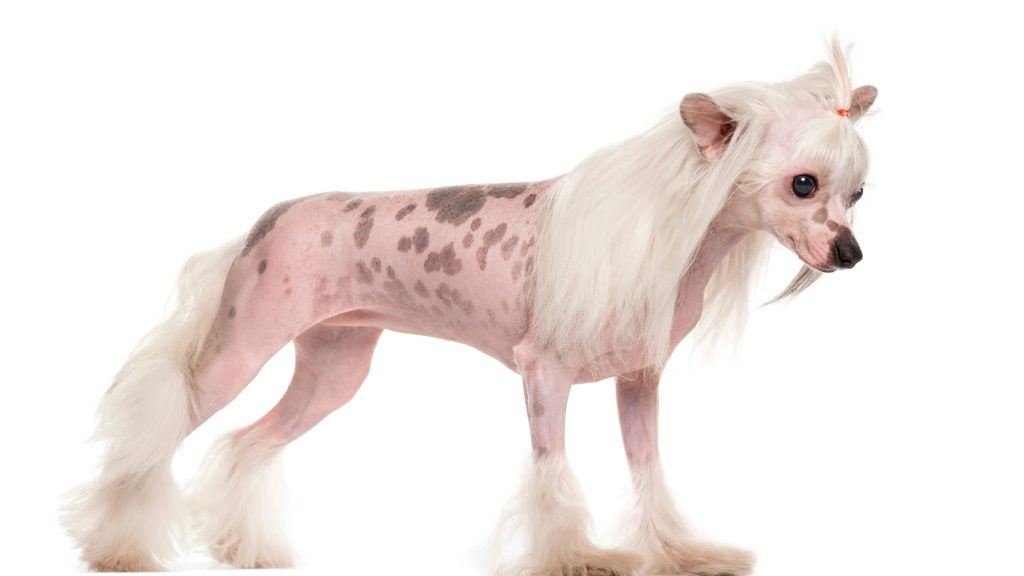
- Hairless Variety: This variety has smooth, soft skin with tufts of hair on the head (crest), tail (plume), and feet (socks). The hairless Chinese Crested’s skin can come in various colors and patterns, often spotted or mottled.
- Powderpuff Variety: The Powderpuff variety is fully covered in a soft, silky double coat that gives it a fluffy and elegant look. Despite their differences, both varieties can be born in the same litter.
Historical Background
The exact origins of the Chinese Crested are somewhat mysterious, but it is believed that the breed dates back to ancient times. Historical records suggest that hairless dogs, including the Chinese Crested, existed in various parts of the world, including Africa and Asia. These dogs were often kept on ships as ratters and companions by sailors. The Chinese Crested, in particular, gained popularity in Chinese port cities, where they were treasured for their companionship and unique appearance. They were also believed to have healing powers and were often used in traditional medicine.
Personality and Temperament

Chinese Cresteds are known for their lively, affectionate, and playful nature. They are highly social dogs that thrive on human companionship and enjoy being the center of attention. Despite their small size, they have big personalities and can be quite spirited and alert. Chinese Cresteds are intelligent and can be easily trained, although they can sometimes exhibit a stubborn streak. They are generally good with children and other pets, making them great family companions. Their affectionate and loyal nature means they form strong bonds with their families and can be quite protective.
Grooming and Skin Care
Caring for a Chinese Crested involves specific grooming and skin care routines, especially for the hairless variety:
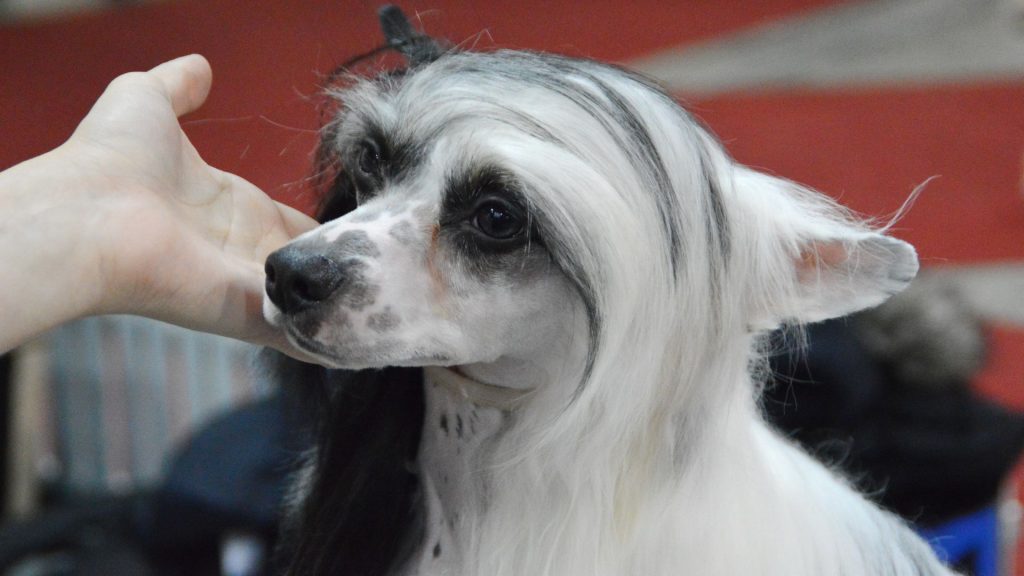
- Skin Care (Hairless Variety): The hairless Chinese Crested’s skin requires regular attention to prevent dryness, sunburn, and acne. Using gentle, hypoallergenic moisturizers and sunscreen can help maintain healthy skin. Regular baths with mild shampoo are also necessary to keep their skin clean.
- Coat Care (Powderpuff Variety): The Powderpuff variety needs regular brushing to prevent mats and tangles in their long, silky coat. Bathing every few weeks helps keep their coat clean and healthy.
- Dental Care: Both varieties can be prone to dental issues, so regular brushing of their teeth is important to prevent periodontal disease.
- Nail Trimming: Regular trimming of their nails is essential to prevent overgrowth and discomfort.
Health Concerns
Chinese Cresteds are generally healthy dogs, but they are prone to certain health issues:
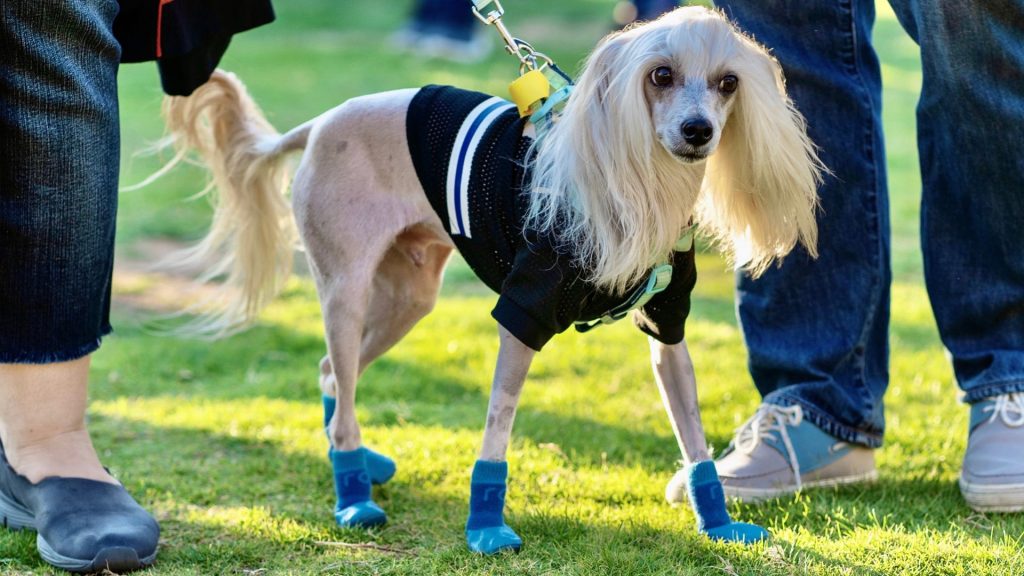
- Skin Problems: The hairless variety can be susceptible to skin issues such as sunburn, acne, and dryness. Proper skin care is essential to prevent these problems.
- Dental Issues: Both varieties can experience dental problems, including tooth decay and gum disease. Regular dental check-ups and cleaning are important.
- Patellar Luxation: This condition, where the kneecap slips out of place, can affect Chinese Cresteds and may require surgical intervention.
- Eye Conditions: They can be prone to certain eye problems, such as progressive retinal atrophy (PRA) and lens luxation.
Best Living Environment and Family Compatibility
Chinese Cresteds are highly adaptable and can thrive in various living environments:

- Best Living Environment: They are well-suited to apartment living due to their small size and relatively low exercise needs. However, they do enjoy outdoor playtime and walks. They should be protected from extreme temperatures, especially the hairless variety, which can be sensitive to both heat and cold.
- Family Compatibility: Chinese Cresteds make excellent family pets due to their affectionate and social nature. They are generally good with children and other pets, provided they are properly socialized. Their playful and gentle demeanor makes them great companions for families, singles, and seniors alike.
Chinese Crested is a unique and charming breed with a lively personality and distinctive appearance. Whether hairless or Powderpuff, these dogs bring joy and companionship to their families. With proper care, grooming, and attention, Chinese Cresteds can thrive in a variety of living environments, making them wonderful and adaptable pets.
Lhasa Apso

The Lhasa Apso has a rich and ancient history, originating in the Himalayan region of Tibet over a thousand years ago. Bred by Tibetan monks and nobility, these small dogs were highly regarded as sacred and were often found in Buddhist monasteries. The Lhasa Apso served as both a watchdog and a companion, alerting monks to any intruders while providing loyal companionship. They were believed to bring good fortune and were considered a spiritual protector. The breed’s name is derived from Lhasa, the capital city of Tibet, reflecting their deep cultural and religious significance.
Physical Appearance and Distinctive Coat
Lhasa Apsos are known for their distinctive and elegant appearance:
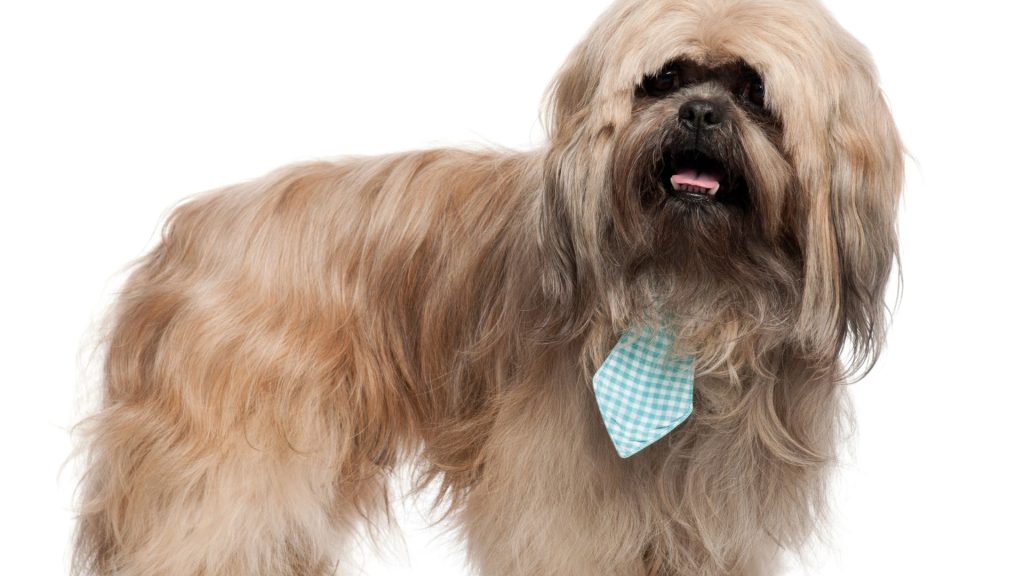
- Size: They are small dogs, typically weighing between 12 to 18 pounds and standing about 10 to 11 inches tall at the shoulder.
- Coat: One of the most striking features of the Lhasa Apso is its long, flowing double coat. The coat can come in various colors, including gold, cream, and smoke, often with darker tips. The hair is dense, straight, and heavy, which helps protect them from the harsh Himalayan climate.
- Face: They have a distinctive face with a strong, rectangular muzzle, dark eyes, and a black nose. Their ears are pendant and heavily feathered, contributing to their overall regal appearance.
Personality Traits
Lhasa Apsos are known for their confident, independent, and alert nature. Despite their small size, they possess a strong-willed and assertive temperament, often described as “big dogs in small bodies.” They are naturally suspicious of strangers, making them excellent watchdogs. However, once they warm up to someone, they can be incredibly loyal and affectionate.
These dogs are intelligent and can be quite stubborn, requiring consistent and patient training. They are also known for their playful and mischievous side, enjoying interactive games and mental stimulation. Lhasa Apsos are deeply devoted to their families and thrive on companionship and attention.
Grooming and Maintenance
Maintaining a Lhasa Apso’s beautiful coat requires regular grooming:
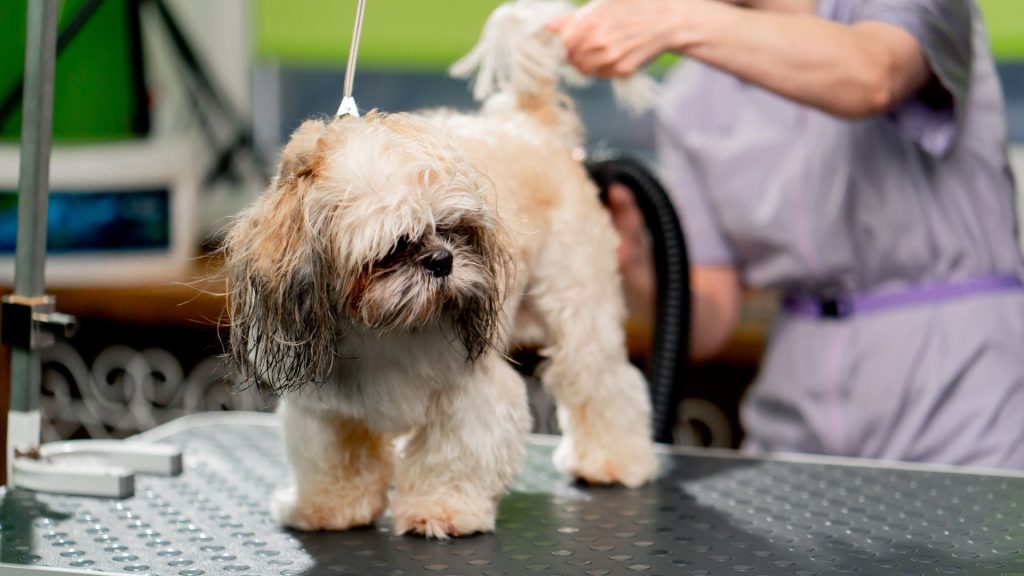
- Brushing: Their long coat needs daily brushing to prevent mats and tangles. Using a quality pin brush and comb can help keep their coat in good condition.
- Bathing: Regular baths, typically every two to four weeks, help maintain their coat’s cleanliness and health. Thorough drying is essential to prevent skin issues.
- Trimming: Many owners opt for professional grooming to keep their dog’s coat in a manageable length, especially around the face and paws.
- Dental Care: Regular brushing of their teeth is important to prevent dental issues.
- Eye and Ear Care: Regular cleaning of their eyes and ears helps prevent infections and tear staining.
Common Health Issues
Lhasa Apsos are generally healthy, but they are prone to certain health issues:
- Hip Dysplasia: This genetic condition can lead to joint pain and mobility issues.
- Patellar Luxation: This condition, where the kneecap slips out of place, can cause discomfort and may require surgical intervention.
- Progressive Retinal Atrophy (PRA): A degenerative eye disorder that can lead to blindness.
- Kidney Disease: They can be prone to certain hereditary kidney problems.
- Skin Allergies: They may develop allergies that affect their skin, requiring special diets or treatments.
Adaptability to Various Living Situations
Lhasa Apsos are highly adaptable and can thrive in a variety of living situations:

- Apartments: Their small size and moderate exercise needs make them well-suited to apartment living. They enjoy short walks and indoor playtime.
- Homes with Yards: They can also thrive in homes with yards, provided they have a secure, fenced area to explore and play.
- Families: Lhasa Apsos are good with older children and can coexist with other pets when properly socialized. They may not tolerate rough handling, so interactions with young children should be supervised.
- Singles and Seniors: Their loyal and affectionate nature makes them excellent companions for singles and seniors. They enjoy being close to their owners and can provide valuable companionship.
Lhasa Apso is a charming and ancient breed with a rich history and a distinctive appearance. Their confident and independent nature, combined with their adaptability and loyalty, makes them wonderful companions for a variety of households. With proper grooming, care, and attention, Lhasa Apsos can bring joy and companionship to their families for many years.
Chinese Chongqing Dog
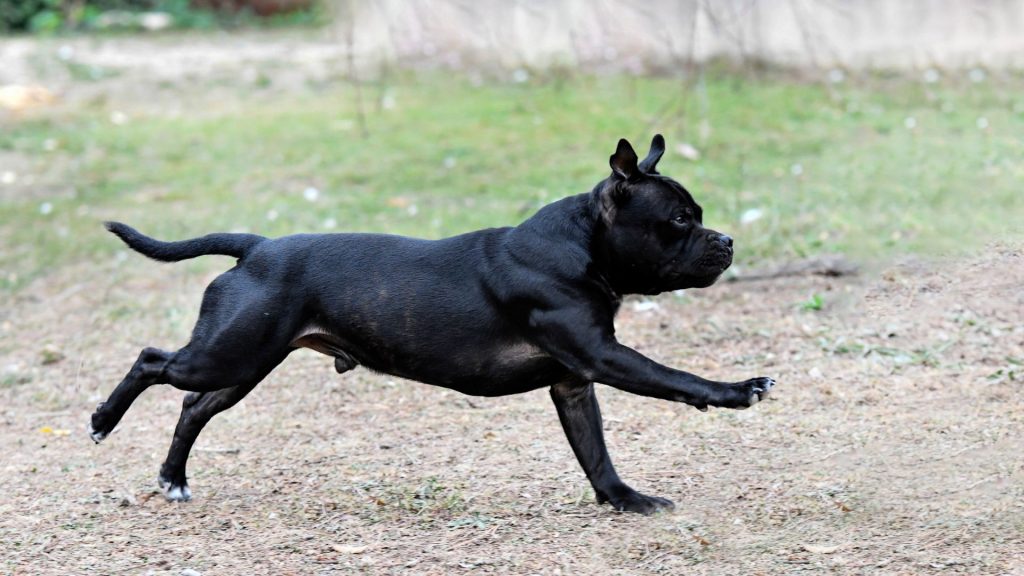
The Chinese Chongqing Dog is an ancient and rare breed, with origins dating back over 2,000 years to the Han Dynasty. Originally from the Chongqing region in southwestern China, these dogs were primarily used for hunting and guarding. Their strong, agile bodies and keen senses made them excellent hunters, while their loyalty and protective instincts made them reliable guardians of homes and livestock. Despite their long history, the breed remained relatively unknown outside of China until recent years. The Chongqing Dog’s deep-rooted history and cultural significance in China add to its unique charm and appeal.
Physical Characteristics
The Chinese Chongqing Dog is known for its distinctive and robust appearance:
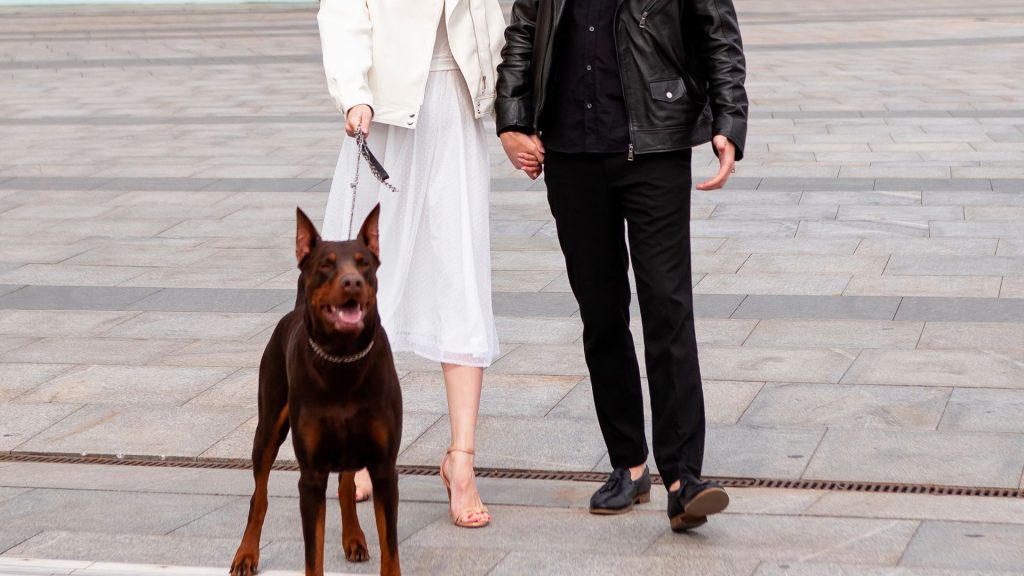
- Muscular Build: These dogs have a powerful and muscular physique, giving them an athletic and sturdy look. They are medium-sized, typically weighing between 44 to 54 pounds and standing about 14 to 20 inches tall at the shoulder.
- Short Coat: The coat of the Chongqing Dog is short, dense, and coarse, providing protection from the elements while requiring minimal grooming. The coat color is usually a rich reddish-brown or dark brown.
- Distinctive Features: They have a broad, flat head with a pronounced stop, erect ears, and a strong jaw. Their tails are often carried high and curl over the back, adding to their alert and confident demeanor.
Personality and Temperament
Chinese Chongqing Dogs are known for their loyal, courageous, and protective nature. They form strong bonds with their families and are deeply devoted to them. These dogs are naturally wary of strangers, making them excellent watchdogs. They are intelligent and alert, always aware of their surroundings and ready to protect their home and loved ones.
Despite their protective instincts, Chongqing Dogs can be gentle and affectionate with their family members. They are known to be good with children and can coexist with other pets if properly socialized from an early age. Their independent and sometimes stubborn nature means they require consistent and firm training to ensure they are well-behaved and responsive.
Grooming and Care
Caring for a Chinese Chongqing Dog is relatively straightforward, given their short coat and robust health:
- Brushing: Their short coat requires minimal grooming, with weekly brushing to remove loose hair and keep their coat healthy.
- Bathing: Occasional baths, typically every few months, help maintain their coat’s cleanliness and shine. Ensure thorough drying to prevent skin issues.
- Dental Care: Regular brushing of their teeth is important to prevent dental problems and maintain overall health.
- Nail Trimming: Regular trimming of their nails is essential to prevent overgrowth and discomfort.
- Ear and Eye Care: Regular checks and cleaning of their ears and eyes help prevent infections and ensure they remain healthy.
Health Considerations
Chinese Chongqing Dogs are generally healthy, but they can be prone to certain health issues:
- Hip Dysplasia: This genetic condition can lead to joint pain and mobility issues. Regular check-ups and maintaining a healthy weight can help manage this condition.
- Skin Issues: Due to their short coat, they can be prone to skin irritations and allergies. Proper grooming and a balanced diet can help prevent these problems.
- Brachycephalic Syndrome: Their short muzzle can sometimes cause breathing difficulties, especially in hot or humid weather. Avoid strenuous exercise during extreme temperatures.
Ideal Environment and Suitability as a Pet
Chinese Chongqing Dogs are best suited to certain living environments and families:
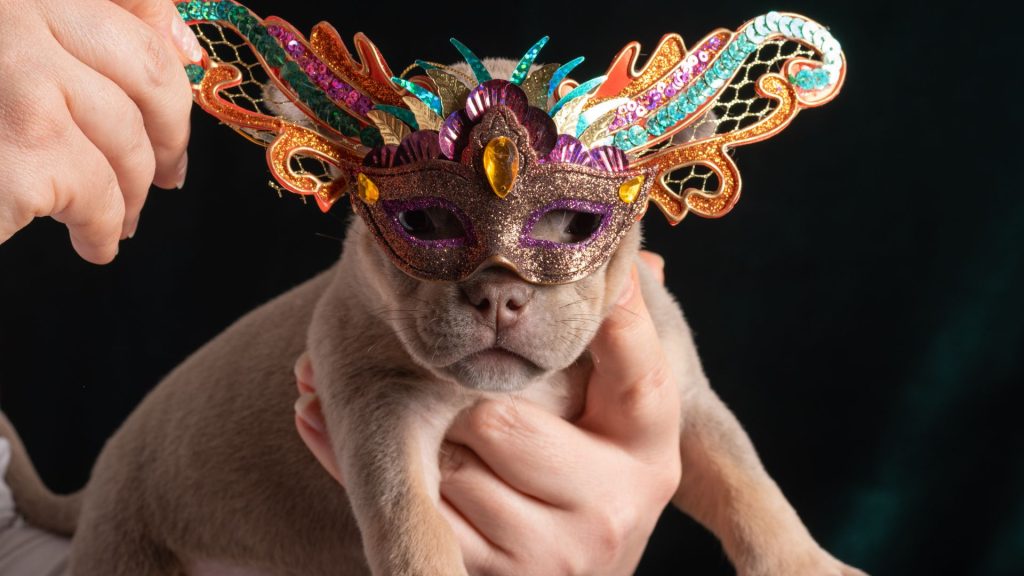
- Ideal Environment: These dogs thrive in homes with secure, fenced yards where they can safely explore and patrol. They enjoy regular exercise and playtime but can also adapt to apartment living if given sufficient outdoor activity.
- Suitability as a Pet: Chongqing Dogs make excellent pets for experienced dog owners who understand their unique needs and characteristics. They require consistent training and socialization to ensure they are well-behaved and responsive. Their protective nature makes them ideal for families looking for a loyal and vigilant companion. They can be good with children and other pets if properly socialized, but they may not tolerate rough handling or overly boisterous behavior.
Chinese Chongqing Dog is a unique and ancient breed with a rich history and distinctive appearance. Their loyal and protective nature, combined with their low grooming needs and robust health, makes them wonderful companions for the right families. With proper care, training, and attention, Chongqing Dogs can be loyal and loving members of any household.
Xiasi Dog
The Xiasi Dog, also known as the Xiasi Quan, hails from the Guizhou province in China, where it has been bred for centuries. Named after the Xiasi village, this breed was traditionally used by local hunters for its exceptional hunting skills and keen senses. Xiasi Dogs were highly valued for their ability to track and capture game, including wild boar and deer. Their importance in rural Chinese communities cannot be overstated, as they provided essential support for subsistence hunting, contributing to the livelihood of their owners.
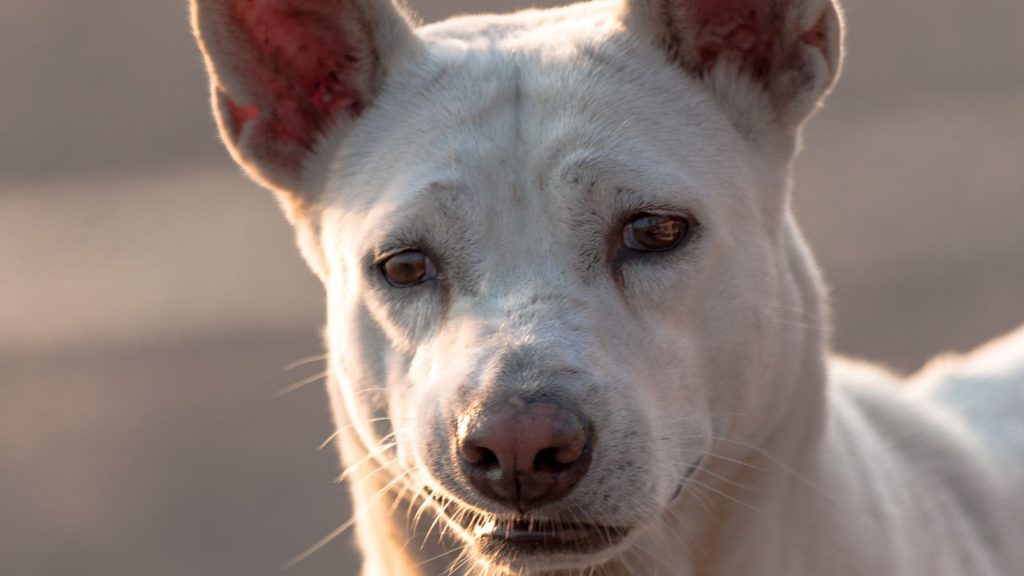
Appearance and Physical Traits
The Xiasi Dog is known for its distinct and athletic appearance:
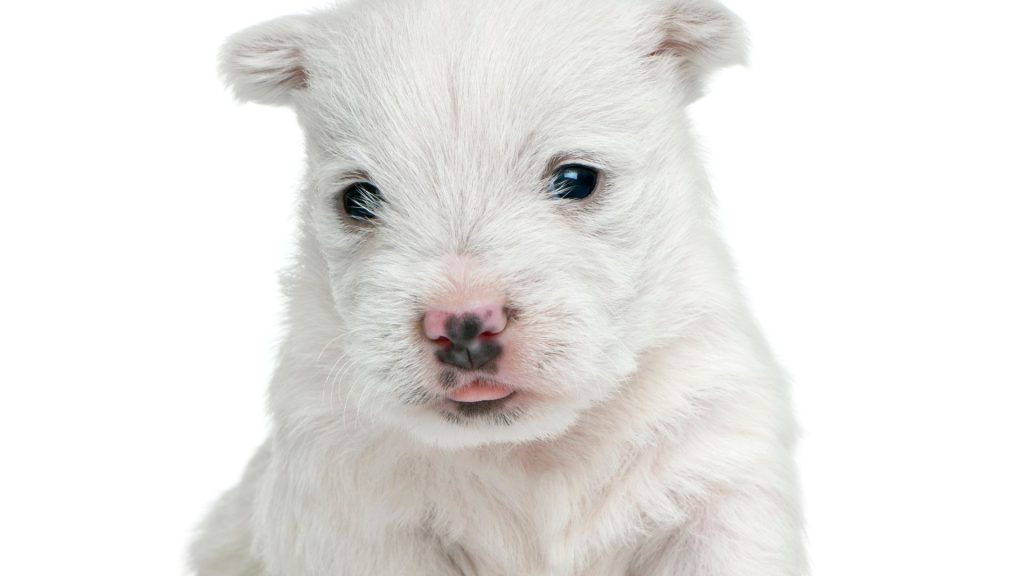
- Build: These dogs have a lean, muscular build that reflects their agility and endurance. They are medium-sized, typically weighing between 44 to 66 pounds and standing about 17 to 20 inches tall at the shoulder.
- Coat: The Xiasi Dog has a short, dense coat that is usually white or pale in color. This coat helps them blend into their environment while hunting.
- Face: They have a narrow, elongated muzzle with a pronounced stop, and their ears are large and erect, contributing to their alert expression.
- Tail: Their tails are typically long and curled, adding to their sleek and agile appearance.
Behavioral Characteristics
Xiasi Dogs are known for their intelligence, loyalty, and strong work ethic. They possess several key behavioral traits:
- Hunting Instincts: Bred for hunting, Xiasi Dogs have a keen sense of smell and excellent tracking abilities. They are determined and persistent, making them formidable hunters.
- Loyalty and Bonding: These dogs form strong bonds with their families and are deeply loyal. They are protective and will alert their owners to any potential threats.
- Energy Levels: Xiasi Dogs are highly energetic and require regular exercise to stay happy and healthy. They enjoy outdoor activities and thrive when given tasks to perform.
- Trainability: They are intelligent and eager to please, which makes them relatively easy to train. However, they can be independent and require consistent, firm guidance.
Grooming and Care Needs
Caring for a Xiasi Dog involves specific grooming and maintenance routines:
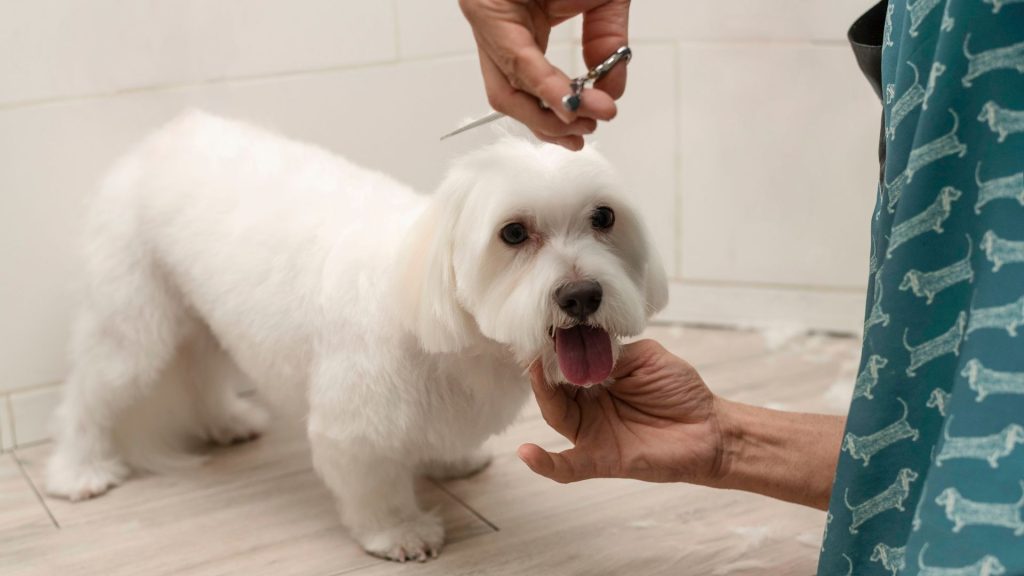
- Brushing: Their short coat requires minimal grooming, with weekly brushing to remove loose hair and keep their coat healthy.
- Bathing: Occasional baths, usually every few months, help maintain their coat’s cleanliness. Ensure thorough drying to prevent skin issues.
- Dental Care: Regular brushing of their teeth is important to prevent dental problems and maintain overall health.
- Nail Trimming: Regular trimming of their nails is essential to prevent overgrowth and discomfort.
- Exercise: Xiasi Dogs require regular exercise to burn off their high energy levels. Daily walks, playtime in a secure area, and opportunities for mental stimulation are crucial.
Health Issues
Xiasi Dogs are generally healthy, but they are prone to certain health issues:
- Hip Dysplasia: This genetic condition can lead to joint pain and mobility issues. Regular check-ups and maintaining a healthy weight can help manage this condition.
- Skin Problems: Their short coat can make them susceptible to skin irritations and allergies. Proper grooming and a balanced diet can help prevent these problems.
- Eye Conditions: They may be prone to certain eye issues, such as cataracts and progressive retinal atrophy (PRA).
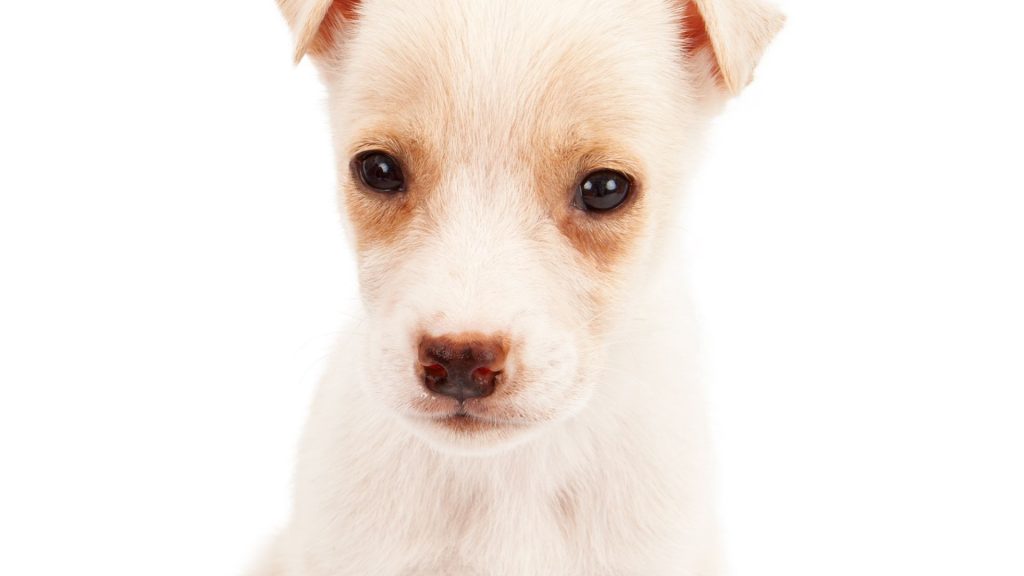
Family Compatibility and Living Conditions
Xiasi Dogs can be excellent family pets for the right households:
- Family Compatibility: They are loyal and protective, making them great companions for families. They are generally good with children and can coexist with other pets if properly socialized. However, their high energy levels mean they are best suited to active families who can provide ample exercise and mental stimulation.
- Living Conditions: Xiasi Dogs thrive in environments where they have plenty of space to run and play. Homes with large, secure yards are ideal. They can adapt to indoor living as long as they receive sufficient outdoor exercise. Their hunting instincts mean they may not be well-suited to homes with small animals unless carefully managed.

Xiasi Dog is a unique and ancient breed with a rich history and distinctive appearance. Their intelligence, loyalty, and high energy levels make them excellent companions for active families who can meet their exercise and training needs. With proper care and attention, Xiasi Dogs can be loyal and loving members of any household.
Conclusion
Chinese dog breeds offer a fascinating array of diversity and uniqueness, each with its distinct history, appearance, and temperament. Understanding the breed-specific needs and traits is crucial for potential owners to ensure a happy and healthy relationship with their pets. From the loyal Shar Pei to the regal Pekingese, these breeds provide unique companionship and protection, making them excellent choices for various households. Considering a Chinese dog breed when looking for a new pet can bring a touch of ancient culture and unparalleled loyalty to your home. The contribution of Chinese dog breeds to global canine diversity is immense, showcasing a rich heritage that continues to captivate and enrich the lives of dog lovers worldwide.
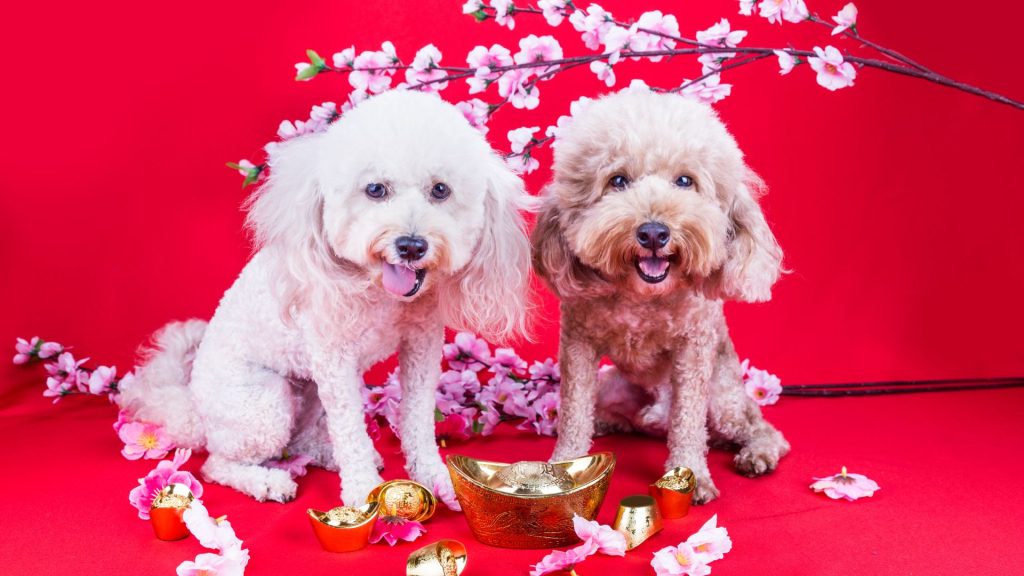
Top 7 FAQs About Chinese Dog Breeds
- What are some popular Chinese dog breeds?
- Popular Chinese dog breeds include the Shar Pei, Shih Tzu, Pekingese, Chow Chow, Tibetan Mastiff, Chinese Crested, and Lhasa Apso. Each breed has unique characteristics and histories that make them fascinating pets.
- Are Chinese dog breeds good with children and other pets?
- Many Chinese dog breeds, such as the Shih Tzu and Lhasa Apso, are known for their friendly and affectionate nature, making them good with children and other pets. However, proper socialization and training are essential to ensure compatibility.
- Do Chinese dog breeds require a lot of grooming?
- Grooming needs vary by breed. For example, the Shih Tzu and Pekingese have long coats that require regular grooming, while the Chinese Crested and Shar Pei have minimal grooming needs. It’s important to understand the grooming requirements of each breed.
- What health issues are common in Chinese dog breeds?
- Common health issues include hip dysplasia, eye problems, skin conditions, and respiratory issues, particularly in brachycephalic breeds like the Pekingese. Regular veterinary care and a healthy lifestyle can help manage these conditions.
- Are Chinese dog breeds easy to train?
- Training ease varies by breed. Breeds like the Shih Tzu and Lhasa Apso are generally intelligent and responsive to training, while others like the Chow Chow and Tibetan Mastiff can be more independent and require consistent, firm guidance.
Discover the charm and diversity of Chinese dog breeds with our in-depth guide. Visit PetFleck.com to explore why these unique breeds make wonderful pets!

Hello, I’m Donna Carter, the founder and writer behind PetFleck.com. My journey with dogs started years ago, and it’s been a passion that has only grown stronger over time. I’ve always been fascinated by the unique behaviors and characteristics of different dog breeds, and this curiosity has led me to dive deep into the world of canine studies.
My love for dogs is the driving force behind everything I do. I’ve dedicated countless hours to researching and understanding the nuances of dog care, training, and breed-specific traits. This dedication helps me create content that is not only informative but also genuinely helpful for fellow dog lovers and owners.
At PetFleck, I combine my extensive knowledge and hands-on experience with my passion for dogs to provide valuable insights and tips. Whether it’s exploring different breeds or offering practical advice on dog care, I aim to share knowledge that makes a real difference in the lives of dogs and their families.
I’m thrilled to share my love for dogs with you through my writing. I hope my articles inspire and inform, helping you to better understand and appreciate the incredible bond we share with our furry friends.
Thank you for visiting PetFleck.com, and I look forward to connecting with you through our shared love of dogs!

